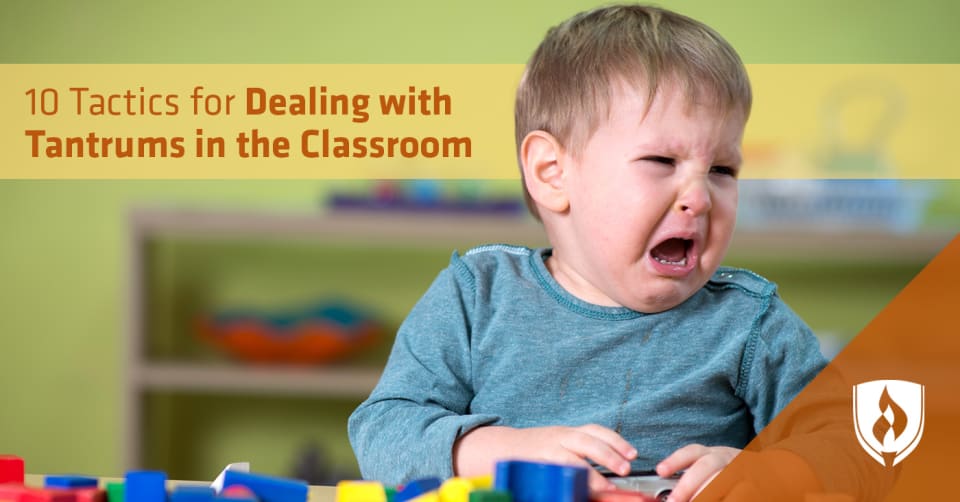
Being a pre-k teacher feels like a dream job. Your typical day includes reading to kids during circle time, watching them create finger-paint masterpieces and singing catchy, educational songs. What could be more enjoyable than watching young ones learn and develop before your very eyes?
But sometimes those adorable angels turn into screaming, crying terrors. When the dreaded temper tantrum rears its ugly head in your classroom, it’s easy to lose patience and control. But don’t fret, these meltdowns happen under the watch of veteran teachers and experienced parents alike. Temper tantrums can be triggered by any number of things, from frustration to hunger to a desire for more independence.
Tantrums are inevitable, but you can still stay in control of your classroom. We’ve talked to seasoned teachers to collect their advice on how to diffuse these difficult situations. Check out these 10 expert tips for dealing with tantrums so you can be prepared the next time a meltdown threatens to strike your classroom.
10 tactics for dealing with tantrums
Handling a tantrum isn’t just about what you do during a child’s meltdown—your actions before and after can make a difference, too! Follow these steps to effectively approach tantrums in every stage, from prevention to aftermath.
What to do BEFORE a tantrum…
There are certain behaviors and strategies you can implement to reduce the risk of a meltdown taking place. Take a look at these tactics:
1. Talk about emotions
“The most important thing to do is talk with kids about tantrums and emotions,” says Joni Kuhn, assistant professor in the Rasmussen University School of Education. She recommends discussing why people get upset at least a few times a week. Try role-playing so the kids have opportunities to think about how to handle their emotions in a positive way when they become upset or frustrated.
2. Know your students
Get to know your students by talking often about their likes and dislikes and what makes them happy or sad. “Finding out what triggers them to become upset is the key in recognizing when a tantrum may be looming,” says Kuhn. She also recommends attempting to read their facial expressions and notice which times of the day are most difficult for them.
3. Pay attention
Once you know a child’s possible triggers, many tantrums can be prevented by keeping a close eye on how they’re doing throughout the day. “Most tantrums start off because a child is hungry, tired or bored,” says Helen Adeosun, founder of CareAcademy. If you can recognize those signs, you’ll be able to offer a child what he or she needs before the meltdown starts.
4. Master the art of distraction
“If you see a toddler or preschooler on the verge of a tantrum, you can step in and try to redirect them with a book or a toy,” advises Kuhn. Directing a child’s attention away from the negative emotions can help him or her calm down before a tantrum begins. Even something as simple as asking how the child is feeling can divert the difficult situation.
What to do DURING a tantrum…
The time will inevitably come when an outburst ensues. How should you react when disaster strikes? Here’s some advice:
5. Keep everyone safe
Some children flail around wildly or throw things during tantrums, so your first job is to keep all of the children safe. Prevent accidents by moving an upset child away from sharp corners or hard edges, and encourage the other children to work on a quiet activity like reading or drawing in nearby area of the classroom, Kuhn recommends.
6. Keep your cool
Child care experts agree that losing your temper and matching the child’s anger is the worst thing you can do during a tantrum. Remember that tantrums are normal for young children, and their behavior is to be expected. “Tantrums help children to work through their feelings and release stress and anxiety,” says Kuhn. “Most adults have unrealistic expectations of how children should behave, and that’s what causes things to become problematic.”
7. Provide a calm space
When kids are overstimulated or frustrated, removing them from the environment can give them space to work through their feelings without becoming even more upset. “Having a quiet space gives children a sense of control and a place to disengage from whatever triggered the tantrum to begin with,” says Adeosun. She recommends designating a calm area that kids know they can visit if needed.
8. Talk through it
When adults are upset, it helps to talk through their problems with a friend who listens. The same is true for children. “Get down on their level and quietly let them know that you understand how they are feeling,” says Kuhn. You can respond if they talk to you, but don’t attempt to force a reply. Your most important role is listening.
What to do AFTER a tantrum…
After a breakdown disrupts the flow of your say, how do you get the class back on track? Check out these tips:
9. Don’t ignore the elephant in the room
Adults often want to avoid talking about a tantrum after it happens, but that’s the wrong strategy, according to Kuhn. “This is why it’s important to talk with kids regularly about what emotions are and good ways to handle issues that come up when we’re upset.” Talking about what just happened may not be your first instinct, but it’s the best course of action to help children understand how to work through their feelings.
10. Encourage empathy
Children need to understand that their friends may have trouble with certain things, like sharing or transitioning from one activity to another, says Kuhn. By having regular, honest conversations about why we feel the way we do, they’ll be in a position to understand how their friend feels when he or she has a tantrum. An empathetic child will be able to be “kind, respectful and helpful in times of tantrums,” says Kuhn.
Keep calm and teach on
Dealing with tantrums isn’t easy, but it just got a lot more manageable thanks to these expert tips from educators. The next time a tantrum comes your way, you’ll be calm, collected and prepared to help your preschoolers work through their meltdowns.
For more advice on how to be prepared for anything, check out this article: 7 Things I Wish I Knew Before Becoming a Preschool Teacher.
Related Article:




